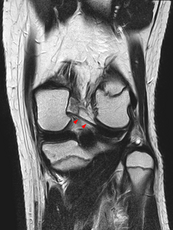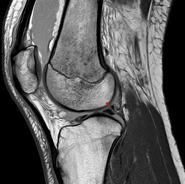Posterior meniscofemoral ligament
Appearance
| Posterior meniscofemoral ligament | |
|---|---|
| Details | |
| From | lateral meniscus |
| To | femur |
| Identifiers | |
| Latin | ligamentum meniscofemorale posterius |
| TA98 | A03.6.08.004 |
| TA2 | 1887 |
| FMA | 76855 |
| Anatomical terminology | |
The Posterior meniscofemoral ligament (also known as the ligament of Wrisberg) is a small fibrous band of the knee joint. It attaches to the posterior area of the lateral meniscus and crosses superiorly and medially behind the posterior cruciate ligament to attach to the medial condyle of the femur.[1]
It forms with articulatio meniscolateralis anterior articulatio mesicofemoralis which is the upper floor of articulatio genus. It flexes and extends functionally as ginglymus with frontal axis.
The posterior meniscofemoral ligament is found in 64.4% of the subjects in MRI scan of the knee.[1]
-
Posterior meniscofemoral ligament on MRI, coronal
-
Posterior meniscofemoral ligament on MRI, sagittal
-
Posterior meniscofemoral ligament (Wrisberg) behind the posterior horn of the lateral meniscus close to its insertion. Sometimes wrongly interpreted as a meniscal tear.
References
- ^ a b Bintoudi, A.; Natsis, K.; Tsitouridis, I. (2012-09-17). "Anterior and Posterior Meniscofemoral Ligaments: MRI Evaluation". Anatomy Research International. 2012: 1–5. doi:10.1155/2012/839724. ISSN 2090-2743.
{{cite journal}}: CS1 maint: unflagged free DOI (link)



